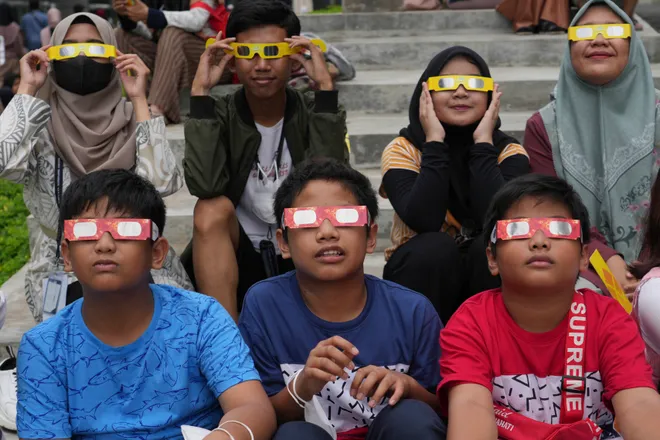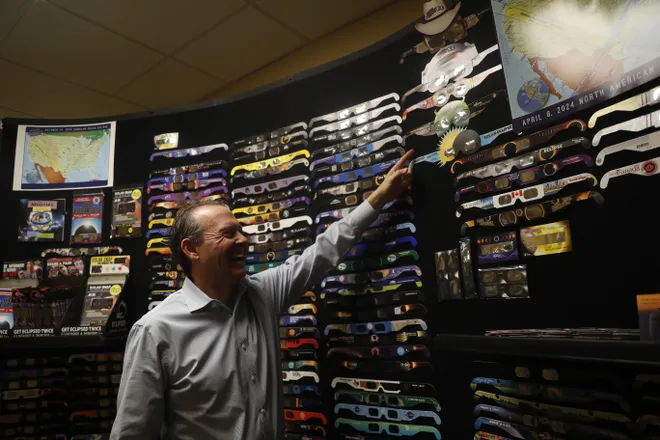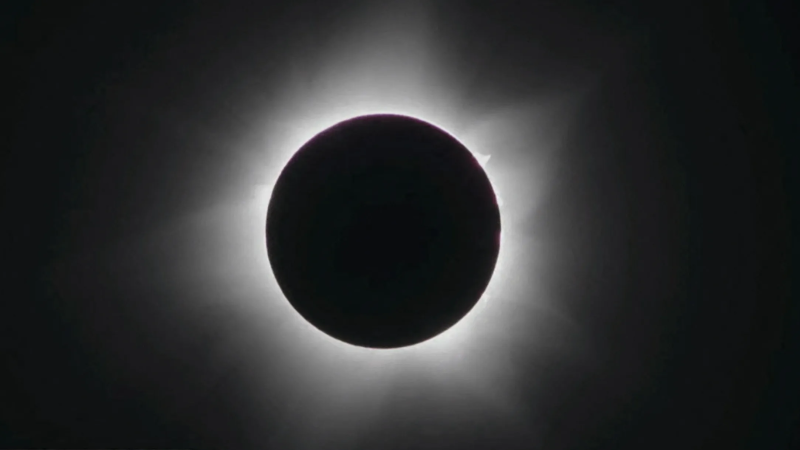Looking for last-minute solar eclipse glasses? These libraries and vendors can help
The upcoming annular solar eclipse may be described as a "ring of fire" for the circular halo that will appear, but the moniker is apt for another unintended reason.
If spectators don't wear proper eyewear to watch as the moon passes in front of the sun to create the dazzling effect, the powerful rays could quite literally burn their eyes and damage their retinas. Come Saturday, potentially millions of people across the United States will be drawn to look to the skies to glimpse the rare annular solar eclipse, which astronomers warn will be the last opportunity to see the phenomenon until 2039.
But gazing at the sun with the naked eye is never wise. That's why astronomers also caution that celestial enthusiasts be prepared with the proper eyewear to view the ring of fire as NASA said it will travel in the U.S. from the coast of Oregon to the Texas Gulf Coast.

How to safely watch the solar eclipse:Rare 'ring of fire' has the potential to damage your eyes if you don't take precautions
Where to find solar eclipse glasses
According to NASA, the only safe way to watch an eclipse is through a pair of approved solar eclipse glasses or a handheld solar viewer.
Fortunately for stargazers, solar eclipse glasses are readily available for purchase and even for free ahead of the ring of fire, which should be viewable in some form in all lower 48 states.
But don't confuse the specialized eyewear with your run-of-the-mill sunglasses: certified solar eclipse glasses are held to an international safety standard and are 100,000 times darker to block nearly all visible, infrared and ultraviolet light.
Free solar eclipse glasses available at libraries nationwide
In Buffalo, New York, for instance, Erie County officials provided funding to hand out hundreds of thousands of the eyewear at its local libraries, according to the Buffalo Museum of Science.
Many libraries around the country, in fact, will be giving away free pairs of approved eclipse glasses through Saturday. The Space Science Institute distributed 5 million solar-viewing glasses to 10,000 libraries and maintains a map of participating libraries on its website.
Get solar eclipse glasses through American Paper Optics
Residents in Memphis, Tennessee have several options available to acquire solar eclipse glasses, according to the Commercial Appeal, a USA TODAY Network publication. In addition to the city's libraries giving away the eye protection, a popup shop will also be open every day through Saturday where glasses produced by American Paper Optics costing up to $20 are for sale.
American Paper Optics, the nation's largest supplier of eclipse glasses, also offers express shipping across the country.
Plenty of other online sellers have eclipse glasses for sale that are compliant with ISO 12312-2, a long number that simply specifies the properties that a solar viewer should have in order to protect eyes from injury.

Find solar eclipse glasses through approved vendor
For more manufacturers and retailers who sell certified glasses, the American Astronomical Society maintains a curated list of approved vendors.
Of course, Prime Day may be over, but consumers can also turn to Amazon for their eclipse-watching needs. The online retailer has a variety of certified solar eclipse glasses, many of which can be bought in bulk (including a 50-pack for $49.99.)
But be wary of counterfeit or unsafe eclipse glasses when shopping Amazon. If the seller's name is not one of the verified suppliers on the American Astronomical Society's list, look elsewhere.
Will 2024 solar eclipse be better?Real showstopper comes in April when large portions of the country see an even more impressive total eclipse
Why solar eclipse glasses are necessary protection

At least some of the sun’s powerful light will be visible Saturday even in places without a view of the spectacular partial solar eclipse.
Directly staring at the sun at any time can cause blindness or disrupted vision, but the concentrated solar rays of the partial eclipse are especially acute. Looking at it through a camera lens, telescope or binoculars is also dangerous, as the rays can burn through even those filters, according to NASA.
An annular eclipse is different from the nighttime darkness of a total eclipse in which the Moon completely blocks the face of the Sun from Earth's view, the next of which is expected to occur in April.
Rather, an annular solar eclipse occurs when the moon is at the farthest point of its orbit from Earth and passes in front of the sun. Because it is incapable of completely blocking the sun, the moon instead appears as a smaller dark disc in front of the larger and brighter star, creating what looks like a ring of fire.
Weather permitting, the eclipse will first become visible in Oregon around 9:13 a.m. PDT and end in Texas around 12:03 p.m. CDT, according to NASA. It will then move beyond the U.S. and over Mexico, Central America and finally South America before ending around sunset off of Natal, Brazil in the Atlantic Ocean.
Eric Lagatta covers breaking and trending news for USA TODAY. Reach him at elagatta@gannett.com
Disclaimer: The copyright of this article belongs to the original author. Reposting this article is solely for the purpose of information dissemination and does not constitute any investment advice. If there is any infringement, please contact us immediately. We will make corrections or deletions as necessary. Thank you.







